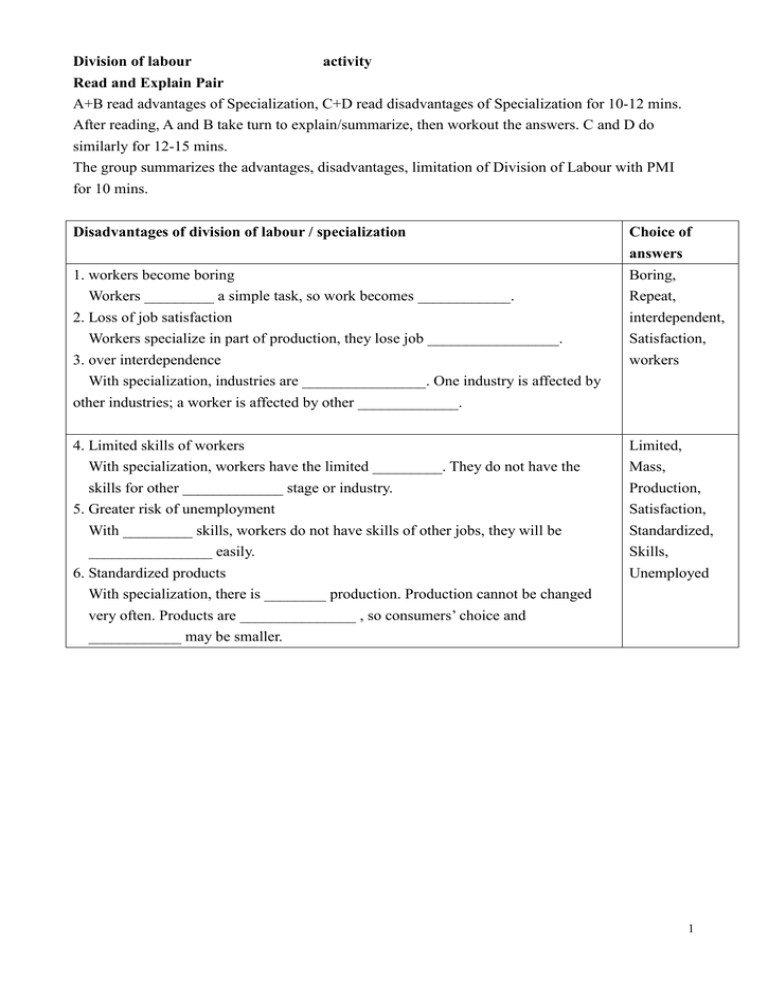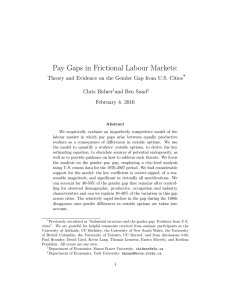division labour students (File 4.2)
advertisement

Division of labour activity Read and Explain Pair A+B read advantages of Specialization, C+D read disadvantages of Specialization for 10-12 mins. After reading, A and B take turn to explain/summarize, then workout the answers. C and D do similarly for 12-15 mins. The group summarizes the advantages, disadvantages, limitation of Division of Labour with PMI for 10 mins. Disadvantages of division of labour / specialization Choice of answers 1. workers become boring Workers _________ a simple task, so work becomes ____________. Boring, Repeat, 2. Loss of job satisfaction Workers specialize in part of production, they lose job _________________. 3. over interdependence With specialization, industries are ________________. One industry is affected by other industries; a worker is affected by other _____________. interdependent, Satisfaction, workers 4. Limited skills of workers With specialization, workers have the limited _________. They do not have the skills for other _____________ stage or industry. 5. Greater risk of unemployment Limited, Mass, Production, Satisfaction, With _________ skills, workers do not have skills of other jobs, they will be ________________ easily. 6. Standardized products With specialization, there is ________ production. Production cannot be changed very often. Products are _______________ , so consumers’ choice and ____________ may be smaller. Standardized, Skills, Unemployed 1 Advantages of division of labour / specialization Choice of answers 1. Assign the right person to do the right job Different workers have different ________, workers do the most suitable _____. Workers are more ____________. 2. Practice makes perfect Workers do the same job ___________. Workers become more ___________ and productive. 3. Save time in training Workers specialize in one job, so _________ time can be saved. 4. Save time in moving round jobs job, productive, repeatedly, skilful, training, talent, time, workers, ________ specialize in one job, they need not move around, traveling and preparation ________ can be saved. 5. Fewer capital goods Workers ___________ in one job, they need fewer ________ goods. Firms can buy enough capital goods to improve workers’ ______________. 6. Capital goods are used efficiently Workers specialize in one job, they use the capital ________ all the time, so capital goods are used _____________. 7. More mechanization With specialization, production is divided into _______ tasks, so it is easier to Capital, Consumers, Efficiently, Goods, Machine, Mechanization, output, Productivity, design __________. Mechanization takes place more easily. Production is more efficient with _______________. 8. Improve standard of living With specialization, production is more efficient, ________ increases. More _______ of goods are produced for leisure. High qualities of goods are produced with mechanization. _____________ consume more and better goods, so _________________________ increases. Simple, Standard of living, Variety, 2 PMI of division of labour: Advantages, disadvantages, limitations Advantages of division of labour Disadvantages of division of labour Limitation of Division of Labour 3 (This is an optional work for students who work very fast) Fill in the missing information about 4 types of division of labour Simple division of labour Complex division of labour Specialize in Specialize in (Who?) Regional division of labour Where? International division of labour specialize in Where? 4 Division of labour Assignment 1. Why workers become more productive with complex division? (How can the productivity of workers be increased in a factory?) Write 5 reasons besides the arrows. 1 2 ------------------------------------------------------------------ 3 4 5 Workers are more productive. 2. Besides raising productivity of labour, indicate 2 reasons that firms consider division of labour can help them to produce more efficiently. (draw a similar diagram as above) Production becomes more efficient. --------------------------------------------------------------------- 3. Draw similar diagram to show workers may not like division of labour. --------------------------------------------------------------------- Workers do not like division of labour 4. Draw similar diagram to show division of labour may have harmful effects to the economy. Harmful effects of ----------------------------------------------------------------------- division of labour to the economy 5






